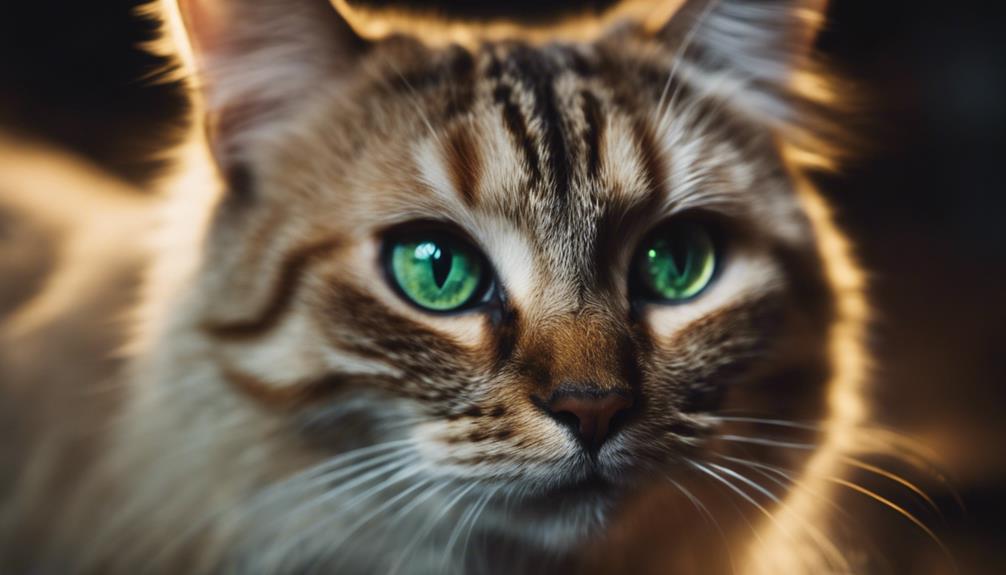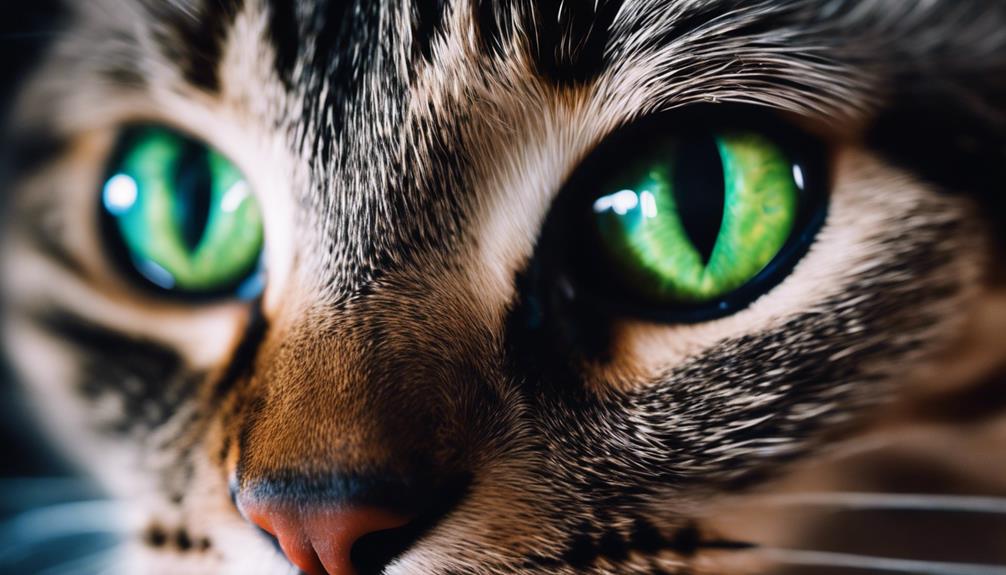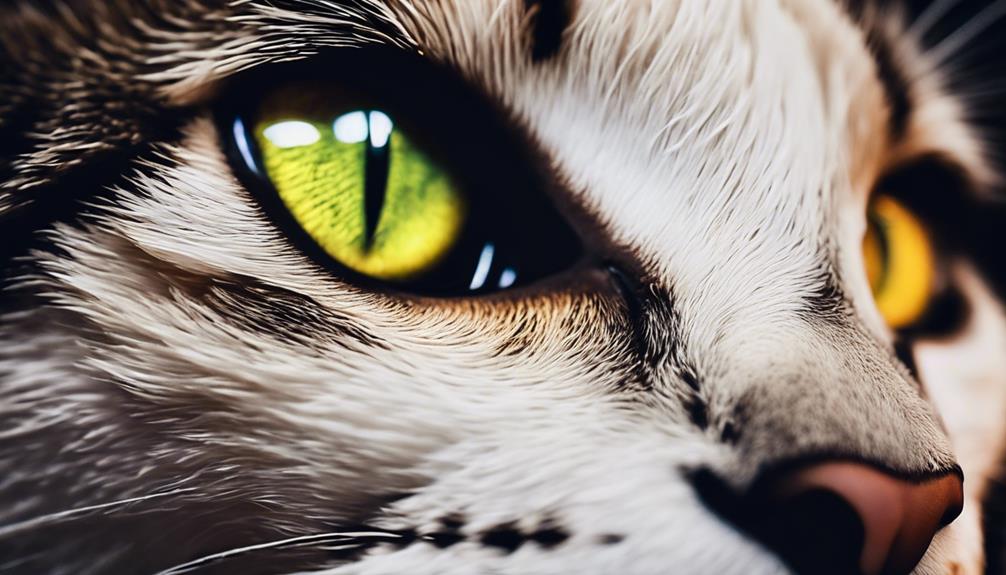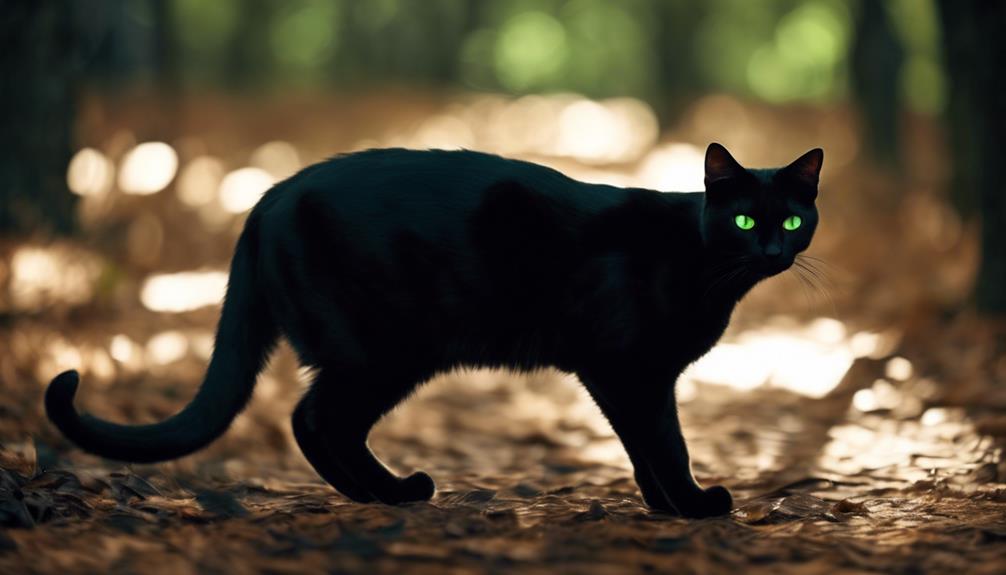The realm of feline vision, particularly in low-light environments, offers a captivating insight into the unique adaptations that distinguish cats from humans.
While the common belief in cats' exceptional night vision holds merit, the intricacies of their ocular biology reveal a more complex reality.
From specialized eye structures to the presence of the tapetum lucidum, cats possess a suite of evolutionary advantages that cater to their nocturnal prowess.
Exploring the nuances of how cats navigate darkness unveils a world where sensory superiority reigns, leaving us to ponder the mysteries of their visual acuity compared to our own.
Key Takeaways
- Cat vision excels in low light due to more rod receptors.
- Cats lack color vision but have enhanced night vision.
- Cats can detect small movements and details effectively.
- Cats have a wider field of vision and sharp vision at night.
Cat Vision at Night
During the twilight hours and into the night, cats' specialized vision allows them to navigate their surroundings with remarkable clarity and precision.
Unlike humans, cats' eyes are adapted for low-light conditions, making them well-suited for activities in dimly lit environments. Cats possess a higher number of rod receptors in their retinas, which are crucial for night vision.
Additionally, cats have a unique reflective layer called the tapetum lucidum that enhances their ability to see in the dark. This adaptation enables cats to detect movement and details in low light levels, giving them a significant advantage during nighttime activities.
With their exceptional night vision capabilities, cats are proficient hunters and explorers under the veil of darkness.
Adaptations for Nighttime Activities
In the realm of nocturnal endeavors, feline physiology showcases remarkable adaptations tailored for thriving in low-light environments. Cats' eyes possess a specialized structure that aids in their nighttime activities. They have a higher concentration of rod cells in their retinas, enhancing their ability to see in dim light.
Additionally, cats have a tapetum lucidum, a reflective layer behind the retina that improves light sensitivity by reflecting light back through the eye. This adaptation allows cats to make the most of even the faintest glimmers of light in their surroundings.
Coupled with their keen sense of hearing and strong olfactory capabilities, these visual adaptations contribute to making cats efficient and effective hunters under the cloak of darkness.
Cat Vision Vs. Human Vision

Cat vision differs significantly from human vision in terms of specialized adaptations for low-light environments, emphasizing enhanced night vision capabilities and unique sensory features. Cats have a higher number of rod receptors than cone receptors in their retinas, which aids in night vision and detecting motion in dim lighting.
While humans have more cone receptors for color vision in bright light, cats have a tapetum lucidum, a reflective layer behind the retina, enhancing their vision in the dark. This adaptation allows cats to see better in low-light conditions than humans.
Additionally, cats excel in peripheral vision, helping them detect movement from various angles. Understanding these differences sheds light on how cats navigate their environment and hunt effectively during nighttime activities.
Rods Vs. Cones in Cat Vision
The distribution of rod and cone receptors in a cat's retina plays a crucial role in their vision capabilities. Cats have a higher density of rod receptors compared to cone receptors. Rods are essential for detecting low light levels and aiding in night vision.
While cones are responsible for color vision and detail, cats have fewer cone receptors, leading to their limited color perception. Due to this rod-dominated retina, cats excel in low-light conditions but see the world in shades of gray and blue.
This specialization allows cats to navigate and hunt effectively during the night, emphasizing their role as crepuscular predators. Understanding this unique distribution of rod and cone receptors sheds light on the exceptional night vision of our feline companions.
Color Perception in Cats

The distribution of rod and cone receptors in a cat's retina significantly influences their perception of colors. Cats have limited color perception compared to humans due to having more rod receptors than cone receptors. This means they see the world in a more muted palette.
To understand how colors appear to cats, consider the following:
- Cats see in shades of gray, blue, yellow, and possibly green.
- Their color vision is not as vivid as humans.
- They excel at detecting movement and details rather than colors.
- Cats rely more on brightness and contrast to distinguish objects.
- Their visual acuity for colors is not as sharp as humans'.
Peripheral Vision in Cats
When considering feline visual capabilities, the peripheral vision of these animals plays a crucial role in their overall sensory perception. Cats have exceptional peripheral vision, allowing them to detect movement and objects at the edges of their field of view with great accuracy.
This wide-angle vision aids in hunting, as cats can monitor their surroundings for potential prey or threats without needing to move their heads constantly. Unlike humans, cats have a wider visual field, which helps them navigate their environment and stay alert to any changes in their surroundings.
This heightened peripheral vision is a significant advantage for cats in the wild, where awareness of their surroundings is essential for survival.
Tapetum Lucidum in Cats

Cats' tapetum lucidum, a reflective layer behind the retina, enhances their night vision by reflecting light back through the photoreceptor cells.
- The tapetum lucidum acts like a mirror in the eye, giving cats a second chance to see in low light.
- This layer helps cats see better in the dark by maximizing available light.
- The reflective cells in the tapetum lucidum improve cats' vision by bouncing light around.
- Cats' eyes shine at night due to the reflection caused by this layer.
- The tapetum lucidum boosts cats' ability to detect movement and navigate in dimly lit environments.
Cat Sensory Abilities Overview
Building upon the discussion of the tapetum lucidum and its role in enhancing cats' night vision, an exploration into the comprehensive sensory abilities of felines reveals a remarkable array of finely tuned senses that contribute to their prowess as hunters.
| Sensory Ability | Description | Importance |
|---|---|---|
| Sense of Smell | Cats have a strong sense of smell, aiding in detecting prey and marking territory | Essential for hunting and survival |
| Hearing Accuracy | Cats possess sensitive hearing and precise sound localization abilities | Helps in pinpointing prey location and avoiding danger |
| Vision Adaptations | Cats excel in peripheral vision, detecting small movements, and seeing in low light conditions | Crucial for hunting in various environments |
Cats as Effective Hunters

An exploration into the hunting prowess of felines unveils their remarkable efficiency as skilled predators in various environments.
- Cats possess exceptional agility and stealth to stalk prey effectively.
- Their keen senses of sight, smell, and hearing aid in detecting and pursuing targets.
- Cats utilize their retractable claws and sharp teeth for precise and swift takedowns.
- They demonstrate strategic hunting techniques, such as ambush and pounce, to secure meals.
- Cats' innate hunting instincts and adaptability enable them to thrive in diverse ecosystems.
Cat Sensory Superiority
With their heightened sensory acuity, felines possess a remarkable advantage in perceiving and navigating their surroundings. Cats have a strong sense of smell, allowing them to detect scents imperceptible to humans. Their vomeronasal organ enhances their ability to taste and smell, aiding in hunting and navigating their environment.
Cats also have exceptionally sensitive hearing, enabling them to locate sounds with precision, even from a distance. Their capability to discern quiet, high-pitched noises further showcases their sensory superiority. These acute senses collectively contribute to cats' effectiveness as hunters, helping them thrive in various environments.
Conclusion
In conclusion, the intricate adaptations of a cat's night vision system reveal a remarkable superiority over human visual capabilities in low-light environments. With specialized rod receptors, the absence of color perception, and the presence of the tapetum lucidum, cats possess a unique advantage for navigating the darkness.
These evolutionary advantages equip cats for their nocturnal lifestyles, making them highly effective hunters with sensory abilities that far surpass those of humans. Cats truly reign supreme in the realm of night vision.




